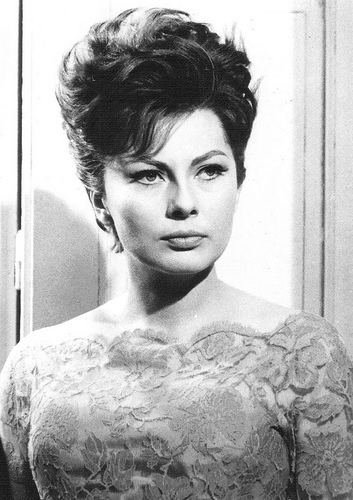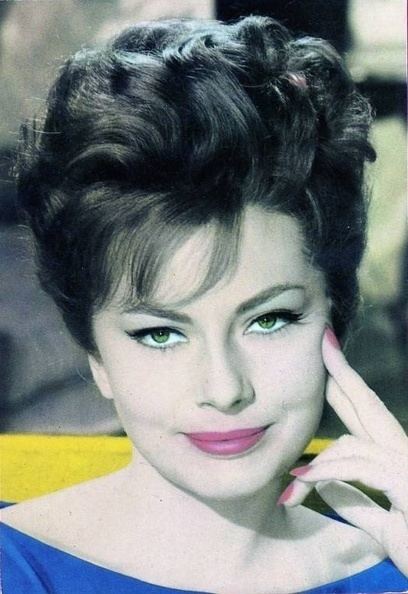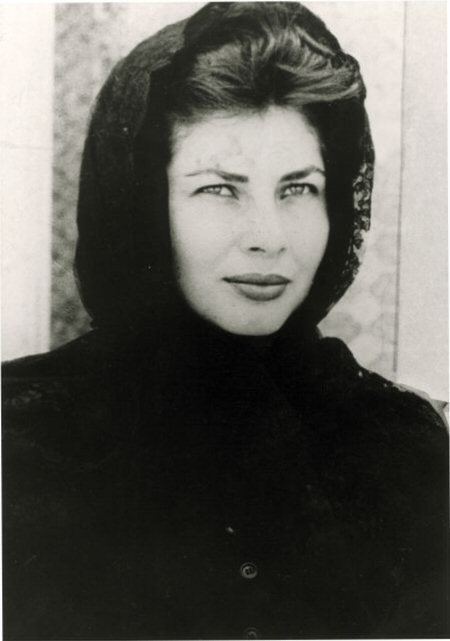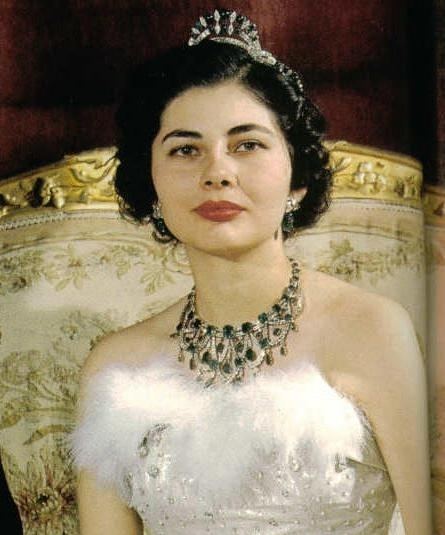Role Actress | Religion Roman Catholic Mother Eva Karl Books Palace of Solitude | |
 | ||
Tenure 12 February 1951 – 6 April 1958 House House of Pahlavi (by marriage) Name Soraya Esfandiary-Bakhtiari Siblings Bijan Esfandiary-Bakhtiari Similar People Mohammad Reza Pahlavi, Farah Diba, Fawzia Fuad of Egypt, Shahnaz Pahlavi, Reza Pahlavi - Crown Pri | ||
Shahbanu Soraya of Iran (born Soraya Esfandiary-Bakhtiari, Lurish/Persian:ثریا اسفندیاری بختیاری, Sorayâ Esfandiyâri-Baxtiyâri; 22 June 1932 – 26 October 2001) was shahbanu (queen) of Iran, the second wife of Mohammad Reza Pahlavi, the last Shah of Iran, and an actress.
Contents
- Early life and education
- Marriage
- Shahbanu of Iran
- Infertility and divorce
- Career as actress
- Later years in Paris
- Death
- Titles
- Memoirs
- Legacy
- Filmography
- References

Early life and education

Soraya was the elder child and only daughter of Khalil Esfandiary-Bakhtiary, a Bakhtiary nobleman and Iranian ambassador to West Germany in the 1950s, and his German wife Eva Karl.

She was born in the English Missionary Hospital in Isfahan (Farsan) on 22 June 1932. She had one sibling, a younger brother, Bijan. Her family had long been involved in the Iranian government and diplomatic corps. An uncle, Sardar Assad, was a leader in the Persian Constitutional Revolution of the early 20th century. Soraya was raised in Berlin and Isfahan, and educated in London and Switzerland.
Marriage

In 1948, Soraya was introduced to the recently divorced Shah Mohammed Reza Pahlavi, by Forough Zafar Bakhtiary, a close relative of Soraya's, via a photograph taken by Goodarz Bakhtiary, in London, per Forough Zafar's request. At the time Soraya had completed high school at a Swiss finishing school and was studying the English language in London. They were soon engaged: the Shah gave her a 22.37 carat (4.474 g) diamond engagement ring.

Soraya married the Shah at Marble Palace, Tehran, on 12 February 1951. Originally the couple had planned to wed on 27 December 1950, but the ceremony was postponed due to the bride being ill.
Although the Shah announced that guests should donate money to a special charity for the Iranian poor, among the wedding gifts were a mink coat and a desk set with black diamonds sent by Joseph Stalin; a Steuben glass Bowl of Legends designed by Sidney Waugh and sent by U.S. President and Mrs. Truman; and silver Georgian candlesticks from King George VI and Queen Elizabeth. The 2,000 guests included Aga Khan III.
The ceremony was decorated with 1.5 tonnes of orchids, tulips and carnations, sent by plane from the Netherlands. Entertainment included an equestrian circus from Rome. The bride wore a silver lamé gown studded with pearls and trimmed with marabou stork feathers, designed for the occasion by Christian Dior. Of all the Shah's many women, it is generally believed that Soraya was the "true love" of his life as she was the one he loved the most.
Soraya later wrote about herself and Iran: "I was a dunce. I knew next to nothing of the geography, the legends of my country; nothing of its history, nothing of the Muslim religion". Soraya's upbringing had been entirely German and Catholic, which left her with a mixed identity, and made the object of much distrust in Iran with Muslim clerics saying the Shah should not marry this "half-European girl" who was not raised a Muslim. Soraya wrote: "The feeling of being both Christian and Muslim, but at the same time of being neither one nor the other has engraved in my flesh two divergent poles between which my existence has unfolded. The one is methodically European, the other savagely Persian".
Shahbanu of Iran
Following the marriage, Soraya headed the charity association in Iran. Soraya's marriage was troubled as Mohammad Reza's mother and sisters all saw her as a rival for his love just as they had with his first wife Princess Fawzia Fuad of Egypt, and continually snubbed and inflicted petty humiliations on her. Soraya hated Ernest Perron, the Shah's best friend and private secretary. Soraya called Perron a "homosexual who detested women, all women" and who "spread poison around the palace as well as our own quarters". She wrote that Perron was a "cunning, perfidious and Machiavellian" man who "roused hatred, stirred gossip, reveled in every intrigue". Much to her disgust, Mohammad Reza was "fascinated with this diabolical Swiss" who professed to be a "philosopher, poet, and a prophet"; the two men met every morning to discuss all the affairs of state in French as Perron was the man whose advice the Shah valued the most, and, as Soraya soon learned, other matters were discussed as well. Much to her revulsion, Perron visited her and made a series of what she called very "lewd" remarks and vulgar questions about her sex life with the Shah, which led her to throw him out of the Marble Palace in her fury.
During the confrontation with Prime Minister Mohammad Mosaddegh of the left-wing National Front, Mohammad Reza was often depressed, being in her words "somber and distressed" to the extent he even stopped playing poker with his friends, which had been one of his main passions. She stated that only sex could lift Mohammad Reza out of his depression, and she often invited the Shah into her bed to keep his spirits up. Several times, Soraya advised Mohammad Reza "to screw up his courage to the sticking point".
In August 1953, Soraya followed the Shah when he fled to Rome, and complained the Iranian ambassador to Italy failed to arrange for a place for them to stay while the royal couple were constantly harassed by the paparazzi. On 19 August 1953, Soraya remembered how a glum Mohammad Reza was talking about moving to the United States when he received a telegram announcing that Mosaddegh had been overthrown, leading him to shout with joy.
After the 1953 coup overthrown Mosaddegh, the Shah's spirits picked up. One of Mohammad Reza and Soraya's favorite activities were masked balls, although Soraya complained the Shah always wore a lion costume (the symbol of royalty) while her attempts to appear as Madame de Pompadour were vetoed under grounds this was inappropriate for a queen, and she forced to appear as Joan of Arc instead. About her husband, Soraya always praised him when he displayed "European" personality traits while criticizing him for "Oriental" behavior. Soraya wrote despite his first marriage and "in spite of countless mistresses he had before me, Mohammad Reza was extremely shy with women...he did not like to show his feelings".
As Soraya was brought up in Europe, Iran was a strange country to her, which the Iranian-American historian Abbas Milani argued explained her attitudes towards ordinary Iranians, which he called borderline racist. Europe was always the model for excellence in everything for her. Soraya described as Queen having to visit "hospitals, orphanages, charities, the people's quarters with their djoubs open to the sky, with streams of dirt water which supplied their dwellings, having first served washerwoman, tramps and dogs. Poverty and squalor. Children with rickets, ravaged women and starving old men, the filth of the alleyways where the houses are no longer houses, where poverty, real poverty prevailed".
In contrast to the emphasis on the "filth" of Tehran, Soraya wrote with open admiration about how Paris "dazzled" her. Soraya described her time in Paris as "everyday my heart was filled with sunshine. Life was light... it was wonderful to be able go to the cinemas, to drink a glass of lemonade on the terrace of the brassie... a pleasure hitherto forbidden." Soraya wrote about her joy at attending school in Europe, unlike the Iranian schools with "the grey uniform, the stove which smoked and polluted the classroom, lessons, homework, work to the point of exhaustion".
In 1954-55, the Imperial couple paid a lengthy visit to the United States, and Soraya who was fascinated with Hollywood and enjoyed meeting American film stars during her stay in Los Angeles. A photograph of Queen Soraya water-skiing in Miami become extremely controversial in Iran. Soraya was widely condemned for her "immorality" for her swimsuit, which was not considered a proper dress for a Muslim, and the photo was banned in Iran in attempt to silence the criticism of the ulema.
Infertility and divorce
Though the wedding took place during a heavy snow, deemed a good omen, the imperial couple's marriage had disintegrated by early 1958 owing to Soraya's apparent infertility. She had sought treatment in Switzerland and France, and in St. Louis with Dr. William Masters. The Shah suggested that he take a second wife to produce an heir, but she rejected that option.
She left Iran in February and eventually went to her parents' home in Cologne, Germany, where the Shah sent his wife's uncle, Senator Sardar Assad in early March 1958, in a failed attempt to convince her to return to Iran. On 10 March, a council of advisers met with the Shah to discuss the situation of the troubled marriage and the lack of an heir. Four days later, it was announced that the imperial couple would divorce. It was, the 25-year-old queen said, "a sacrifice of my own happiness". She later told reporters that her husband had no choice but to divorce her.
On 21 March 1958, the Iranian New Year's Day, a weeping Shah announced his divorce to the Iranian people in a speech that was broadcast on radio and television; he said that he would not remarry in haste. The headline-making divorce inspired French writer Françoise Mallet-Joris to write a hit pop song, Je veux pleurer comme Soraya ("I Want to Cry Like Soraya"). The marriage was officially ended on 6 April 1958. According to a report in The New York Times, extensive negotiations had preceded the divorce in order to convince Queen Soraya to allow her husband to take a second wife. The Queen, however, citing what she called the "sanctity of marriage", decided that "she could not accept the idea of sharing her husband's love with another woman."
In a statement issued to the Iranian people from her parents' home in Germany, Soraya said, "Since His Imperial Majesty Mohammad Reza Shah Pahlavi has deemed it necessary that a successor to the throne must be of direct descent in the male line from generation to generation to generation, I will with my deepest regret in the interest of the future of the State and of the welfare of the people in accordance with the desire of His Majesty the Emperor sacrifice my own happiness, and I will declare my consent to a separation from His Imperial Majesty."
After the divorce, the Shah, who had told a reporter who asked about his feelings for the former Queen that "nobody can carry a torch longer than me", indicated his interest in marrying Princess Maria Gabriella of Savoy, a daughter of the deposed Italian king Umberto II. In an editorial about the rumors surrounding the marriage of "a Muslim sovereign and a Catholic princess", the Vatican newspaper, L'Osservatore Romano, considered the match "a grave danger".
Career as actress
Granted the royal title Princess of Iran after her divorce, she moved to France. Princess Soraya launched a brief career as a film actress, for which she used only her first name. Initially, it was announced that she would portray Catherine the Great in a movie about the Russian empress by Dino De Laurentiis, but that project fell through. Instead, she starred in the 1965 movie I tre volti (The Three Faces) and became the companion of its Italian director, Franco Indovina (1932–72). She appeared as a character named Soraya in the 1965 movie She.
After Indovina's death in a plane crash, she spent the remainder of her life in Europe, succumbing to depression, which she outlined in her 1991 memoir, Le Palais Des Solitudes (The Palace of Loneliness).
Later years in Paris
During her last years Princess Soraya lived in Paris on 46 avenue Montaigne. She occasionally attended social events like the parties given by the Duchess de La Rochefoucauld. Her friend and event organizer Massimo Gargia tried to cheer her up and make her meet young people. Princess Soraya was a regular client of the hairdresser Alexandre Zouari. She also enjoyed going to the bar and the lobby of the Hotel Plaza Athénée located opposite her apartment. She was often accompanied by her former lady-in-waiting and loyal friend Madame Chamrizad Firouzabadian.
Another friend was Parisian socialite, Lily Claire Sarran. In 1979, Princess Soraya wrote to Mohammad Reza as he was dying of cancer in Panama, saying she still loved him and wanted to see him one last time. Mohammad Reza was greatly moved by her letters, and wrote back to her saying he also still loved her and wanted to see her one last time as well, but said the Empress Farah could not be present. In 1980, it was agreed that Princess Soraya would visit Mohammad Reza in Egypt, but he died before she could make the trip, which led Milani to comment that Mohammad Reza and Soraya were truly "star-crossed lovers". Princess Soraya did not communicate with the Shah's third wife Farah Diba, even when both lived in Paris.
Death
Princess Soraya died on 26 October 2001 of undisclosed causes in her apartment in Paris, France; she was 69. Upon learning of her death, her younger brother, Bijan, sadly commented, "After her, I don't have anyone to talk to." Bijan died one week later.
After her funeral at the American Cathedral in Paris on 6 November 2001 – which was attended by Princess Ashraf Pahlavi, Prince Gholam Reza Pahlavi, the Count and Countess of Paris, the Prince and Princess of Naples, Prince Michel of Orléans, and Princess Ira von Fürstenberg – she was buried in the Westfriedhof Quarter Nr. 143, in a cemetery in Munich, Germany, along with her parents and brother.
Since her death, several women have come forward claiming to be her illegitimate daughter, reportedly born in 1962. According to the Persian-language weekly Nimrooz none of the claims have been confirmed. The newspaper also published an article in 2001 which suggested, without proof, that Princess Soraya and her brother had been murdered. Her belongings were sold at auction in Paris in 2002, for more than $8.3 million. Her Dior wedding dress fetched $1.2 million.
Titles
Though her husband's title, shahanshah (King of Kings), is the equivalent of emperor, it was not until 1967 that a complementary feminine title, shahbanu or shahbanou (equivalent of empress), was created to designate the consort of a shah. Farah Pahlavi was the only woman to have this title. Until then, wives of shahs (including Soraya) bore the title Malake (which is comparable with that of queen), though in the popular press they frequently and incorrectly were called "empress".
Upon the divorce, Soraya ceased being a queen, but a day later she was granted the personal style and title of Her Imperial Highness Princess Soraya of Iran.
Memoirs
Princess Soraya wrote two memoirs. The first, published in 1964 and published in the United States by Doubleday, was Princess Soraya: Autobiography of Her Imperial Highness. A decade before her death, she and a collaborator, Louis Valentin, wrote another memoir in French, Le Palais des Solitudes (Paris: France Loisirs/Michel Laffon, 1991), which was translated into English as Palace of Solitude (London: Quartet Books Ltd, 1992); ISBN 0-7043-7020-4.
Legacy
Soraya's divorce from the Shah inspired French songwriter Francoise Mallet-Jorris to write "Je veux pleurer comme Soraya" (I Want to Cry Like Soraya). A French rose grower, bred a sunflower in the former queen's honor, which he called "Empress Soraya".
An Italian/German television movie about the princess's life, Soraya (a.k.a. Sad Princess), was broadcast in 2003, starring Anna Valle as Soraya and Erol Sander as the Shah. French actress Mathilda May appeared as the Shah's sister, Princess Shams Pahlavi.
